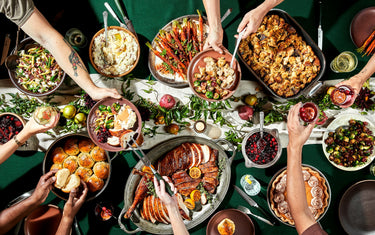6 Do-Ahead Tips for a Relaxed Thanksgiving

Thanksgiving starts now. Yes, we’re talking to you.
Even for skilled home cooks who can throw together dinner on the fly–good for you!–Thanksgiving is one meal that benefits from planning ahead. Well ahead. If you’ve been tasked as the maestro for this year’s feast, follow the advice below for the easiest Thanksgiving you’ve ever had. Here are six tips you need for a more chill holiday.
1. TACKLE THE TURKEY EARLY
The main reason Thanksgiving hotlines exist is because countless cooks buy their turkeys too late and are faced with an impossible choice: Roast a partially frozen bird or try some sketchy quick-thaw technique I found on the Internet? Before you do any further planning, start with the bird you want to serve–and plan ahead accordingly.
A “fresh” turkey is one that has never been chilled below 26° F. You’ll generally find truly fresh turkeys at a farm or specialty market that sources from local farms, so check in with them starting now to ensure you don’t miss your shot. You should order a turkey at least two or three weeks ahead of the holiday, then pick it up one to two days before you cook it (so you have time to brine but don’t hog fridge space!)
Most turkeys you’ll find at the grocery store are still frozen or “previously frozen,” which can feel thawed when you poke them but are likely still very icy in the center. (Remember, these are big birds!)

2. REMEMBER: DAYS, NOT HOURS
Both frozen and previously frozen turkeys need days, not hours to thaw in the refrigerator.
Read that again!
Give yourself 24 hours per four pounds of poultry, plus any additional time you need for dry-brining the bird. If you’re short on time and/or fridge space–and who isn't during Thanksgiving week?!–you can submerge the turkey in cold water or a wet brine, which will take about 30 minutes per pound to thaw.
3. YOU'VE GOT LEGS. KNOW HOW TO SERVE THEM.
Actually cooking the turkey ahead of time is a culinary third rail in some families, but if you can get away with not carving a whole bird at the table, then we highly recommend separating the legs from the carcass and braising them or cooking them sous vide. (Here’s a great primer on the latter.) Then roasting the rest of the turkey on Thanksgiving, which will both decrease cooking time and yield a juicier breast. (And ahem, have you seen our epic turkey breast recipe?)

4. FREEZE MOST OF THE MEAL AHEAD OF TIME
If you have lots of freezer space, you’re in luck: Most Thanksgiving classics can be fully cooked and frozen days or weeks ahead of time. This list includes pureed soups, mashed potatoes, sweet potato puree, stuffings, gratins, casseroles, stocks, gravy, cranberry sauce, cornbread, dinner rolls, cakes and pie crusts. Even many classic pies—including apple, pecan and pumpkin—can be assembled and frozen, then baked straight from the freezer. And while this strategy allows you to prepare most of the feast well in advance of Thanksgiving, make sure you have a plan and timeline for defrosting and reheating each dish or you’ll end up in an à la minute meltdown.
5. PREP EVERYTHING ELSE AHEAD OF TIME
Even dishes you don’t make and freeze ahead of time can benefit from some advanced prep. Any ingredient that requires peeling, chopping or other knife work can be prepared a day or two ahead. Chop onions, carrots, celery and other vegetables and refrigerate them in separate bags or containers. The same goes for all but the most delicate of herbs. Blanch green beans, broccoli and Brussels sprouts a day or two ahead as well. Wash and spin-dry salad greens and store them in a container covered with a paper towel, which will keep them fresh for up to two days). Cube stuffing-bound bread and leave it on a baking sheet to dry out for a day or two. Make dressings, vinaigrettes, gravies, sauces, or dips ahead—most will actually improve in flavor after a day or two in the fridge. If you’re cooking mashed potatoes on Thanksgiving, you can peel and refrigerate them in water for a couple of days. Stuffings, casseroles and other oven-baked sides can be assembled a day or two and stored in a cooler with ice (assuming your refrigerator is already full).

6. KEEP EVERYTHING WARM UNTIL SHOWTIME
If you follow the advice above, your Thanksgiving day checklist will be dramatically shortened. The real challenge will be making sure everything hits the table at its optimal serving temperature, but luckily, your kitchen is full of ways to keep stuff warm.
Oven space will be precious, but yours might have a warming drawer that you use to store baking pans. Now’s the time to use it for its intended purpose! Insulated bottles are excellent for keeping gravies and sauces hot. Empty coolers—especially fancy insulated ones—will keep finished sides warm for hours. Microwaves are also well insulated and will hold food much longer than the countertop. A gas grill is basically an outdoor oven; set anything you want to keep warm opposite a burner set on low. Slow cookers and electric pressure cookers like Instant Pots can hold mashed potatoes, sweet potato purees, soups and so much more.
Lastly, ask your guests if they own any chafing dishes they can lend you for the day; chances are the wise elders in your family own a set.
“A bottle of wine and a chafing dish” is an easy-enough directive for a guest to follow! Have a great–and relaxed–Thanksgiving.





